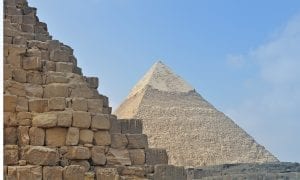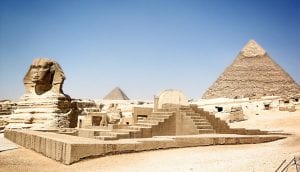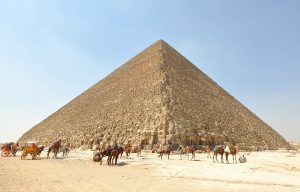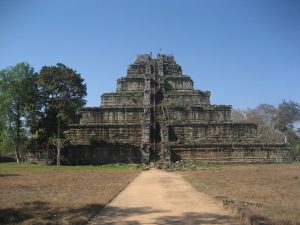Pyramids are truly amazing. They date back for thousands of years, and they’ve served all kinds of intriguing purposes – though largely for honoring the dead, as you’ll soon discover! Most famously, the pyramids of Giza were once used to help mark the passing of Egypt and Nubia’s rulers and pharaoahs during ancient times.
And yet, despite the fact that pyramids are pretty famous the world over, they’re still super-mysterious! The veil of mystery has been lifted a little over the years, but there’s still quite a bit for us to learn.
For a start, did you know that there are pyramids all over the world, not just in Egypt?
In this fact file, I’ll take you through some of my favorite facts about these majestic structures – and hopefully, we’ll crack a mystery or two along the way. Let’s get excavating some fun facts about pyramids!
1. It’s true – you’ll find pyramids across the continents.
Pyramids have been discovered that date from many different ages and many different countries, including Egypt, Sudan, Ethiopia, Greece, Cyprus, Italy, India, Thailand, Mexico, South America, and also on some of the Pacific islands.
And, of course, there are many modern pyramids built around the world, too. You might even find a few built across the US and Canada – though hopefully with the help of modern equipment!
2. Egyptian pyramids are thought to have been built to honor pharaohs.
There are all kinds of ideas as to why the ancient Egyptian pyramids were originally built. Studies and archaeology appear to show that they were monuments built to appease the pharaohs or rulers of the time.
In fact, they weren’t just erected as projects to appease the royal family! The ancient pyramids of Egypt served a much deeper purpose – to house the bodies of dead pharaohs for centuries to come. Pyramids are said to represent the ancient Egyptian view that death is merely the next step on a much longer journey.
3. Pharaohs’ pyramids were stocked with items they’d take into the afterlife.
It’s believed that pyramids were stocked up with items and trinkets that a pharaoh’s followers would believe he’d need to be able to move on into the afterlife.
Again, this supports the idea that the Egyptian people saw entombing pharaohs as an act of “packing for a trip,” rather than burying them and saying goodbye forever. It’s a fascinating way of looking at mortality and handling grief.

4. The exact number of Egyptian pyramids is debatable.
Believe it or not, there is still ongoing discussion and research regarding the number of pyramids that are standing in Egypt! Scholars tend to agree that there are at least 100 remaining, though many also support the claim that there are around 118.
The reason scholars seem to be so hesitant to offer a precise number is simply because there’s disagreement over what constitutes a pyramid at all. What’s more, some believe that pyramids that remain in Sudan, which was once part of Nubia (where several pharaohs hailed from), should be counted.
5. They were built tall and angled for a reason.
Yes, bizarrely, there are a few specific reasons why Egypt’s pyramids are the shape they are.
Built to have smooth, angled sides, the Pyramids were supposed to symbolize the rays of the Sun. Their design was a way to help the king’s soul rise to heaven and join the gods, specifically the Sun god Ra.
Some scholars also believe that these mighty structures were inspired by ancient stone shapes called ben-bens. Ben-bens, like pyramids, were also used to help people worship the Sun. What’s more, many Egyptians believed that pharaohs would ascend to the afterlife via Ra’s sunbeams.
6. The oldest pyramid in Egypt… and the world?
The Step Pyramid of Djoser is the oldest known pyramid in Egypt, located in an ancient burial ground called Saqqara, and built around 2630 BC.
However, the title for the world’s oldest pyramid is hotly contested elsewhere. Historians believe that the Caral Pyramids, built in Caral, Peru, are approximately the same age. We may never know if Egypt can claim this world record!

7. Egypt can lay claim to one of the world’s largest pyramids.
Built in 2584 BC, the Great Pyramid of Giza, one of three collectively called the Great Pyramids of Giza, is the largest one, and it has stood for thousands of years!
Based on the outskirts of the modern city of Cairo, just to the west of the River Nile, you’ll find the pyramid standing proudly at 147 m tall, which is around 481 feet.
It’s estimated that the structure weighs almost 6 million tons – but how on earth could you weigh such a structure in full?
8. Many people worked tirelessly on the Great Pyramid.
For twenty years, more than 100,000 people worked away at the Great Pyramid’s structure for up to a season every year while the Nile flooded. At this time, it was deemed impossible for people to farm their land properly, and most of the inhabitants were unemployed.
It’s also considered a myth that Giza’s Great Pyramid was built by slaves! In fact, historians now believe that they were the creation of craftspeople of incredible talent – but who were in fact willing to raise the magnificent structure in some truly harsh conditions. That’s admirable!
9. Egypt’s pyramids often had a glittering finish.
It’s believed that the ancient Egyptian pyramids once benefitted from a glittery finish or powdering, thanks to a scattering of limestone. From what we know of the ancient Egyptians, putting on a show is hardly surprising!
Therefore, as magnificent as Egypt’s pyramids look now, they once shined in the Sun – at least, that’s what historians and archaeologists can surmise!
10. Sudan has more pyramids than Egypt.
Yes – shocking! Believe it or not, Sudan is thought to be home to more pyramids and tombs than what you might find in Egypt. Across the Sudanese sands, close to the River Nile, there are more than 200 different structures.
Again, this is partly thanks to the fact several pharaohs hailed from the region once known as Nubia, which we know today as Sudan. For that reason, archaeologists and historians studying ancient Egypt often study Sudan alongside.
11. Much of Sudan is covered with world heritage sites.
Many of the Sudanese pyramids have been recognised by UNESCO as world heritage sites. For example, the marvelous pyramids of Meroe, where the ancient Kush people once lived and traded.
It’s thought that around 100 different pyramids can still be found out in Meroe alone – and we only know of them thanks to the work of French naturalist Frédéric Cailliaud, who discovered and revealed the structures in the early 1800s. Interestingly (though not advisably nowadays), Cailliaud even etched his name into one of the ancient stones!
12. Sudan might have more pyramids than Egypt, but they’re much smaller!
The pyramids in Sudan aren’t as historically significant as the ones in Egypt, or as large. Still, the Sudanese pyramids were found with hieroglyphics, mummies, and treasures. Interestingly, they weren’t restricted to members of the royal family.
In fact, even priests and high-ranking officials would often be buried with a small pyramid atop their graves.
13. Egypt still has the tallest pyramids in the North African contest.
As mentioned, Sudan’s pyramids are pretty small compared to Egypt’s, meaning it’s hardly surprising that it holds the prize for the tallest pyramid in the region.
Of course, that pyramid is the Great Pyramid of Giza, which stands grandly at an impressive 137.5 m, or around 451 feet tall. Believe it or not, it’s thought to have been even taller – after vandalism and erosion over the years, it’s shrunk from a once-majestic 146.7 m, or around 481 feet tall.
14. Egypt’s pyramids tend to be more popular than Sudan’s.
Despite the greater quantity of pyramids in Sudan, the Egyptian ones are more popular with tourists!
Egypt is often bursting with tourists, with around nine million people visiting the region to explore the pyramids up close every year. Sadly, the same can’t be said about Sudan, where its own pyramids are less of a tourist draw.
15. The Great Pyramid is strategically positioned.
Perhaps most fascinating of all is that the Pyramid of Giza appears to be at the dead centre where the longest lines of latitude and longitude meet. This was discovered by Dr. Joseph Seiss, and it suggests that it’s the epicenter of the world!
In fact, pyramids were designed and positioned to also mimic the four points on the compass. That means each point is assigned to north, south, east, and west. It’s thought Egyptians did this because they watched the sky’s rotation via the North Celestial Pole.

16. No one’s too sure of how many pyramids there were in Mexico.
Over to America, now – and nobody knows the exact number of pyramids that once stood in Mexico.
Sadly, the pyramids in the Aztec capital of Tenochtitlán are long gone, but thankfully dozens of others across Mexico still stand. Some people claim that there may have been hundreds scattered across the region – and today, you’ll find remaining structures towards the center of the country and even across the jungles.
17. Many different people and cultures helped to build Mexico’s pyramids.
Pre-Columbian cultures like the Olmecs, Mixtecs, Toltecs, Zapotecs, Aztecs, and Maya created these fascinating structures. Each civilization left a mark with its specific building style, though they all used materials like clay, stone, and mortar.
That said, some of the structures in Mexico – such as the Pyramid of the Sun – remain fairly mysterious. No one is sure why were they built, and who created them.
18. The Mexican pyramids are said to be thousands of years old.
The most important pyramids were built over roughly two millennia, starting from around 900 B.C.E. to about 1000 C.E.
That said, there is some evidence that pyramids out here might be as old as 3,000 years old! The most recent pyramids raised in Mexico, however, are said to have been constructed within the last millennium.

19. Mexico’s pyramids are easy to spot all around.
You can find them along Mexico’s eastern coast, as well as inland, around Mexico City, and farther south in Oaxaca. As mentioned, there are some of the remaining structures found in the surrounding jungles, and some are even up on high in the hilly regions.
20. Mexico’s biggest pyramid is still extremely popular.
The 53m-tall Great Pyramid of Cholula also has a church at its peak and a variety of different tunnels and paths. It’s a popular tourist site as well as a functioning chapel for worship.
It even holds a couple of interesting records. Believe it or not, this pyramid is the largest of its kind in the world based on volume alone! It’s also home to the largest archaeological or dig site for a pyramid the world over. Take that, Egypt!
21. Italy even has its own pyramid – incredible!
Even though it’s flanked by modern roads and buildings and it’s not as large as those you’ll find in Egypt or Sudan, the Pyramid of Cestius remains a hugely popular Italian landmark. It’s believed that this structure is a Roman monumental tomb built for Gaius Cestius dating back to 18BC. However, we understand that you need special permission to get in and take a look around.

22. There are thousands of pyramids still standing across the globe.
The number of pyramids still standing across the globe is thought to be more than 5,000 in total. That means you don’t have to just take vacations to Egypt or Sudan to explore some of these majestic structures. In fact, those two countries house what’s probably less than 10% of the pyramids dotted worldwide.
23. One ancient pyramid hid a secret well that we only discovered in 2015!
Yes – even as late as 2015, we were still discovering mysteries left inside pyramids built centuries past. In this particular case, it’s thought that a well measuring 20 m or around 65 feet deep was discovered below Chichen Itzá’s Pyramid of Kukulcan.
What’s even more fascinating is the fact the well was discovered completely by accident! Scientists came across the hidden feature while exploring electrical currents across the area.
Bizarrely, the well went undiscovered for so long despite the region being recognized as a modern wonder of the world and as one of Mexico’s most popular tourist areas!
24. There are pyramids inside pyramids!
The sacred well isn’t the only interesting feature about the Pyramid of Kukulcan. Just one year after this well was discovered, archaeologists unearthed a truly bizarre sight – another pyramid built into the first!
This is thought to have been the third in a sequence of pyramids built here – and it was discovered more than 80 years after the second structure was located. Never believe that we’ve discovered absolutely everything – there are always fascinating treasures yet to be explored!
25. You can even find forgotten pyramids hidden out in the east.
Pyramid fans will no doubt be fascinated to learn that there’s a pyramid based out in Koh Ker in Cambodia. Specifically, I’m referring to the Pyramid of Prasat Thom, which is barely 100 km or 62 miles from Khmer City.
However, Prasat Thom went undiscovered by most for centuries. The temples based out here were erected in around the 10th century, but eventually became overgrown by jungle vegetation for hundreds of years.
It was only in the 19th century that the French military rediscovered the structures! Even now, it’s a hidden gem for many people, as it’s thought only around 12,000 people head out to the site each year.

26. Each ancient Egyptian pyramid stone was seriously heavy.
Let’s head back to Egypt for some final facts. Remember how I mentioned that building the ancient pyramids was a lot of work, even if those taking part genuinely wanted to help? It’s thought each stone in the Great Pyramid of Giza, for reference, was around 2.5 tons.
Considering there are more than two million blocks in the whole pyramid – that’s a lot of strain! What’s even weirder is the fact no one is completely sure of how these blocks were lifted and moved into place. We’ve learned that sleds were likely involved – but, as always, there’s plenty left for us to uncover…
FAQs about Pyramids
What’s normally inside pyramids?
Pyramids were generally built and used as tombs and mausoleums - tributes, in a way, to Pharaohs and rulers.
Can you go inside any pyramids?
In some cases, yes, tourists are permitted to head inside pyramids. This applies to some of the Great Pyramids in Egypt.
Is it hot inside pyramids?
It’s generally around 68 F inside a pyramid - despite the immense heat outside!
Do you know any interesting facts about pyramids? Share them in the comments below!
Further reading
Discover Egypt – Pyramids of Giza
Smithsonian – The Egyptian Pyramid











